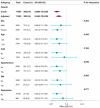Association of the newly proposed dietary index for gut microbiota and constipation: a cross-sectional study from NHANES
- PMID: 39895839
- PMCID: PMC11782033
- DOI: 10.3389/fnut.2025.1529373
Association of the newly proposed dietary index for gut microbiota and constipation: a cross-sectional study from NHANES
Abstract
Objective: The dietary index for gut microbiota. DI-GM is an innovative metric designed to capture the diversity of the gut microbiome, yet its association with constipation remains unstudied.
Methods: In this cross-sectional study, 11,405 adults aged 20 and older were selected from the National Health and Nutrition Examination Survey 2005-2010 for the sample. Constipation was defined as fewer than three defecation frequencies per week using bowel health questionnaire (BHQ). Fewer than three bowel movements per week were considered as constipation by Bowel Health Questionnaire (BHQ). DI-GM was derived from dietary recall data, including avocado, broccoli, chickpeas, coffee, cranberries, fermented dairy, fiber, green tea, soybean and whole grains as beneficial elements, red meat, processed meat, refined grains, and high fat as detrimental components. Multivariable weighted logistic was employed to investigate the association of DI-GM with constipation. Secondary analyses included subgroup analyses, restricted cubic spline (RCS), and multiple imputation.
Results: A higher DI-GM and beneficial gut microbiota score were associated with a lower prevalence of constipation (DI-GM: OR = 0.82, 95% CI = 0.75, 0.90; beneficial gut microbiota score: OR = 0.77, 95% CI = 0.67, 0.89). After grouping DI-GM, in the fully adjusted model, participants with DI-GM ≥ 6 were significantly negatively correlated with both the prevalence of constipation (OR = 0.48, 95% CI = 0.33, 0.71). RCS indicated a non-linear relationship between DI-GM and constipation. Subgroup analyses by age, sex and common complications showed no statistically significant interactions (p > 0.05).
Conclusion: The newly proposed DI-GM was inversely related with the prevalence of constipation. When treating patients with constipation, it is necessary for clinicians to provide timely and effective dietary interventions incorporating the DI-GM for patients with constipation to avoid further deterioration of the condition.
Keywords: DI-GM; NHANES; bowel health; constipation; cross-sectional study.
Copyright © 2025 Zhang, Bi, Wu and Qu.
Conflict of interest statement
The authors declare that the research was conducted in the absence of any commercial or financial relationships that could be construed as a potential conflict of interest.
Figures



References
LinkOut - more resources
Full Text Sources

